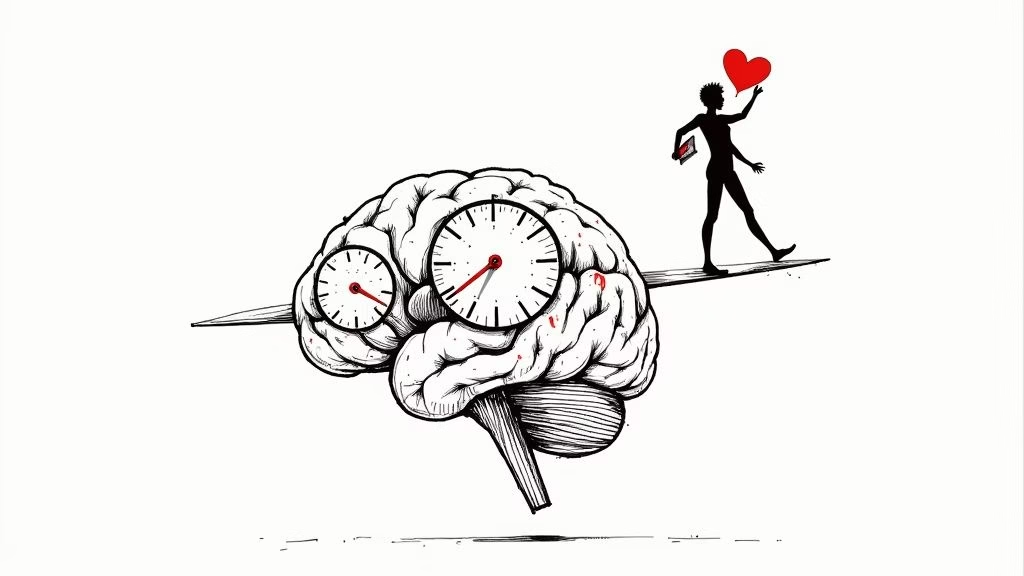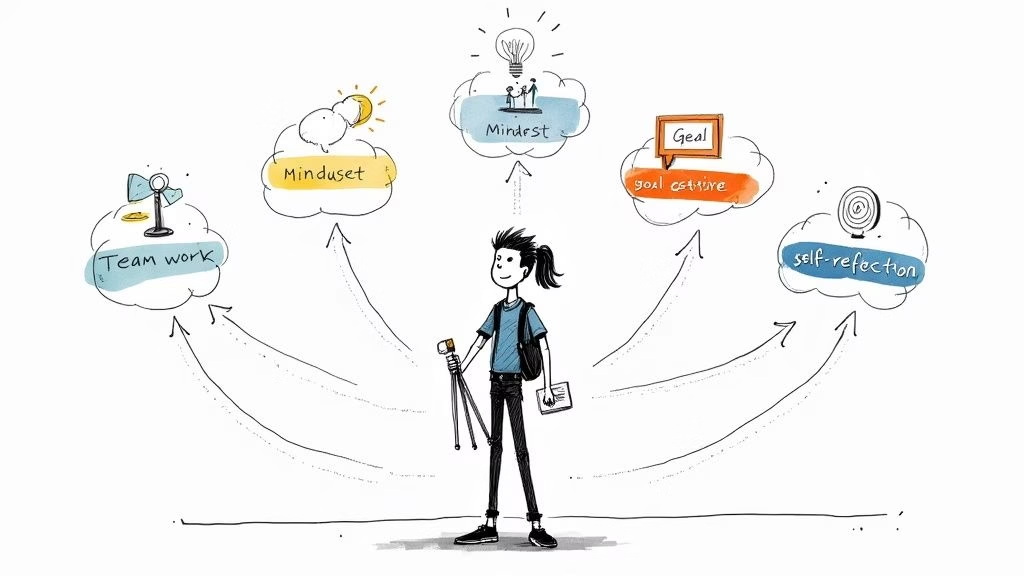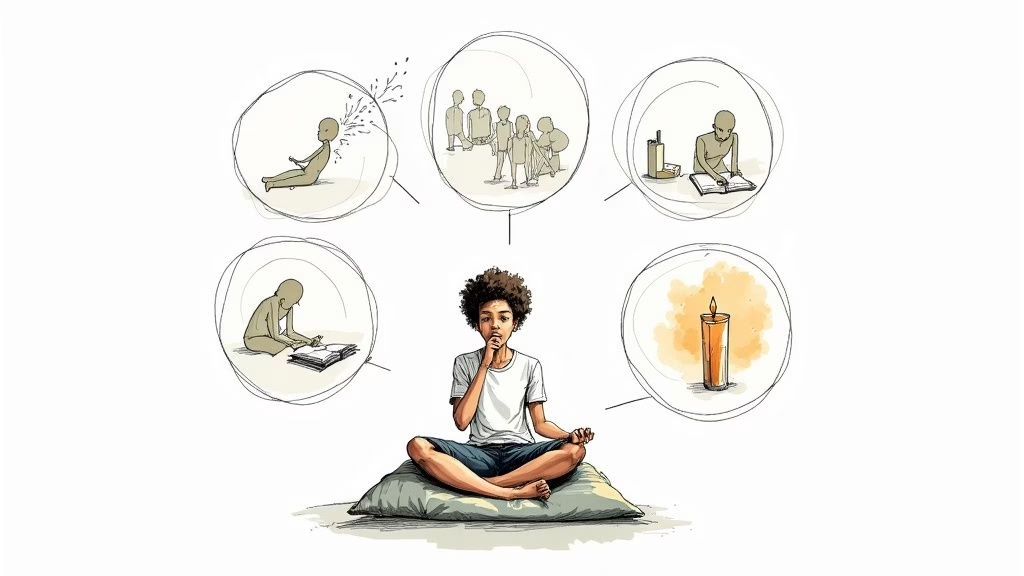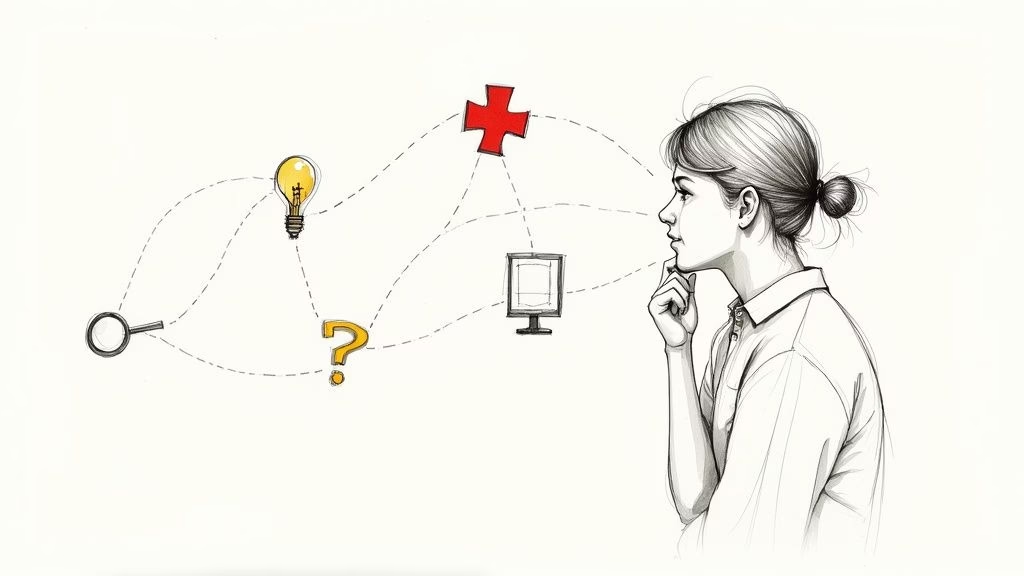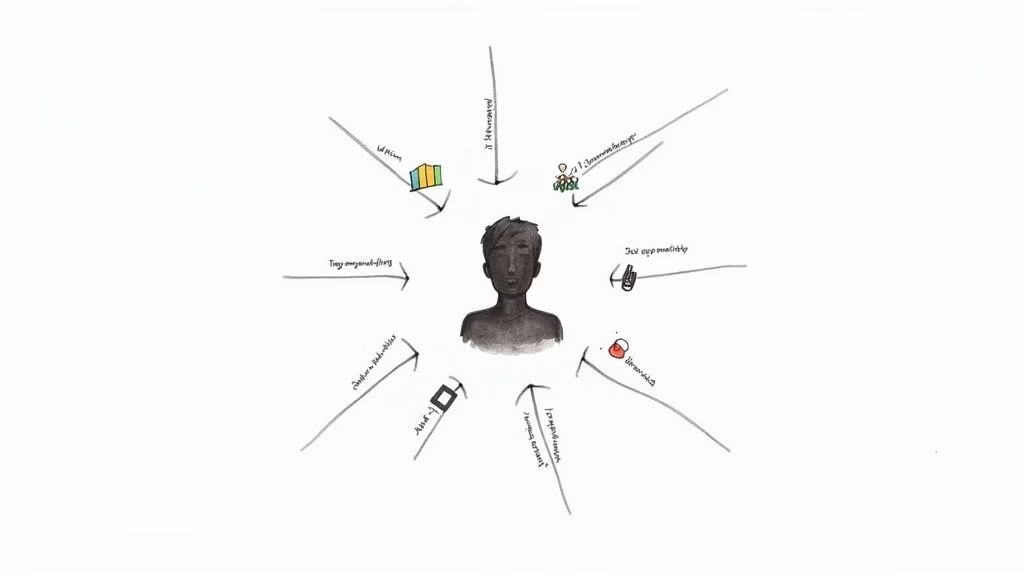The pressure to balance academics, extracurriculars, social life, and personal well-being can feel overwhelming. Many students believe the secret to success lies in a perfectly crafted to-do list, but this often leads to a frustrating cycle of procrastination, stress, and burnout. The real solution is not just managing individual tasks; it is about building reliable systems to make time management easier, creating structure and reducing daily decision fatigue. This article moves beyond generic advice to provide powerful, system-based time management tips for students.
We will explore seven actionable strategies designed to tackle the root causes of procrastination, boost motivation, and create a sustainable framework for both academic and personal growth. Each method is a complete system, from the focus-enhancing Pomodoro Technique to the priority-driven Eisenhower Matrix and the comprehensive Getting Things Done (GTD) method. You will learn not just what to do, but how to implement these frameworks into your daily routine for lasting change. For parents and guardians, we’ll also integrate practical parenting tips and mental health resources to help you support your teen’s journey toward effective self-management and well-being, ensuring they have the tools not just to survive, but to thrive.
1. The Pomodoro Technique: Mastering Focus in 25-Minute Sprints
The Pomodoro Technique is a powerful system for students who struggle with focus and the overwhelming feeling of a massive to-do list. Developed by Francesco Cirillo, this method isn't about working longer; it’s about working smarter within your brain's natural attention cycles. It systematically breaks down your study sessions into focused, 25-minute intervals, known as "pomodoros," separated by short, rejuvenating breaks.
This cyclical system combats mental fatigue and makes even the most daunting tasks, like writing a research paper or studying for finals, feel approachable. By committing to just 25 minutes of focused work, you lower the barrier to getting started, which is often the hardest part and a key trigger for procrastination.
How It Works: A Simple System for Deep Work
The beauty of the Pomodoro Technique lies in its simplicity. You don't need fancy software, just a timer and a plan. This structure is one of the most effective time management tips for students because it builds a reliable study routine that helps combat procrastination and build motivation.
- Choose Your Task: Select one specific task to work on.
- Set the Timer: Set a timer for 25 minutes.
- Work with Zero Distractions: Focus solely on the task until the timer rings. No social media, no texts, no multitasking.
- Take a Short Break: When the timer goes off, take a 5-minute break. Stretch, grab water, or look out the window.
- Repeat and Rest: After completing four pomodoros, take a longer break of 15-30 minutes.
Actionable Tips for Students
To make this method stick, try these practical strategies:
- Start Small: If 25 minutes feels too long, begin with 15-minute intervals and gradually work your way up.
- Use a Physical Timer: A physical kitchen timer is often better than your phone, as it removes the temptation to check notifications.
- Plan Your Pomodoros: The night before, decide which tasks you'll tackle during your pomodoro sessions. This removes decision fatigue.
- Match Breaks to Your Needs: For a mental boost, do something active during your break. If you're feeling drained, practice a minute of mindfulness or meditation.
This technique is a fantastic tool for overcoming procrastination, a common challenge rooted in anxiety and motivation. By focusing on small, manageable sprints, you build momentum and a sense of accomplishment. If you want to dive deeper into why we procrastinate and how to build lasting habits, you can learn more about the mental systems that stop procrastination.
2. Time Blocking: Architecting Your Ideal Day
Time blocking is a powerful scheduling system that moves you from a passive to-do list to an active, intentional plan for your day. Instead of just listing what you need to do, you assign every task a specific time slot in your calendar. This method, championed by high-achievers like Cal Newport and Bill Gates, transforms time from an abstract concept into a concrete resource, giving you a clear visual map of your commitments and capacity.
For students juggling multiple subjects, extracurriculars, and personal time, this approach is a game-changer. It prevents overcommitment by making your time limitations visible, ensuring you allocate sufficient focus to each priority. By scheduling everything, from a chemistry study session to a workout, you take control of your schedule instead of letting your schedule control you.
How It Works: A Simple System for Deep Work
The core principle of time blocking is to give every minute a job. This creates a structured routine that minimizes decision-making throughout the day, freeing up mental energy for deep, focused work on your studies. As one of the most effective time management tips for students, it builds a reliable framework that makes starting tasks easier and reduces procrastination.
- Identify Your Priorities: At the start of the week, list all your major tasks, including classes, homework, project work, and personal commitments.
- Estimate Time Needed: Assign a realistic time estimate to each task. Be honest about how long things will actually take.
- Create Your Blocks: Open your calendar (digital or physical) and schedule these tasks into specific, immovable time slots.
- Include Everything: Block time not just for schoolwork but also for meals, breaks, exercise, and socializing. A balanced schedule is a sustainable one.
- Follow the Plan: When a block starts, work only on the assigned task. Treat these appointments with yourself as seriously as you would an appointment with a professor.
Actionable Tips for Students
To integrate time blocking effectively, try these practical strategies:
- Color-Code Your Life: Assign different colors to different types of activities (e.g., blue for academics, green for personal, red for appointments). This gives you an at-a-glance overview of your day.
- Schedule Buffer Time: Add 10-15 minute buffers between major blocks to allow for transitions, unexpected delays, or a quick mental reset.
- Start with Broad Blocks: Initially, you can create larger blocks like "Morning Study" and "Afternoon Project Work." Refine them into more specific tasks as you get comfortable with the system.
- Conduct a Weekly Review: Set aside 30 minutes each Sunday to review the past week's schedule and plan the upcoming one. Adjust based on what worked and what didn't.
This system is especially beneficial for students who feel overwhelmed and directionless. It provides a clear structure that combats procrastination by defining exactly what you should be working on at any given moment. For more strategies on building these essential skills, you can learn about effective time management systems for teens.
3. The Eisenhower Matrix: Winning the Battle Against Busyness
The Eisenhower Matrix is a decision-making framework that helps students move beyond a chaotic to-do list and focus on what truly matters. Popularized by Stephen Covey and based on a quote from Dwight D. Eisenhower, this system teaches you to distinguish between what is urgent (requires immediate attention) and what is important (contributes to long-term goals). It's a powerful tool for students juggling academics, extracurriculars, and personal commitments.
By sorting tasks into four distinct quadrants, you gain clarity on your priorities, allowing you to dedicate your energy to activities that drive meaningful progress. This systematic approach is one of the most effective time management tips for students because it shifts the focus from being busy to being productive, which boosts motivation by ensuring your efforts are directed toward your goals.
This simple decision tree visualizes how to categorize any task using the matrix.
The flowchart clarifies that a task's true priority is determined by both its urgency and its importance, not just its deadline.
How It Works: A Simple System for Prioritization
The matrix is simple to create and use. You draw a four-quadrant box and categorize every task on your list into one of the following categories, which dictates your next action.
- Quadrant 1: Do First (Urgent & Important): These are crises and pressing deadlines, like a major project due tomorrow or studying for a final exam.
- Quadrant 2: Schedule (Important & Not Urgent): This is the quadrant for long-term success. It includes tasks like planning a research paper, networking, or learning a new skill.
- Quadrant 3: Delegate (Urgent & Not Important): These are interruptions that demand attention but don't advance your goals, like responding to non-critical group chat messages or handling minor administrative tasks for a club.
- Quadrant 4: Eliminate (Not Urgent & Not Important): These are time-wasting activities, such as mindless scrolling on social media or watching irrelevant videos.
Actionable Tips for Students
To integrate the Eisenhower Matrix into your routine, try these strategies:
- Focus on Quadrant 2: Aim to spend most of your time on important, non-urgent tasks. This proactive approach prevents tasks from becoming last-minute crises.
- Be Honest About Quadrant 4: It can be difficult to admit when an activity is a time-waster. Be ruthless in identifying and eliminating these tasks from your schedule.
- Use Digital Tools: Apps like Notion, Trello, or Todoist make it easy to create a digital matrix where you can drag and drop tasks between quadrants as priorities shift.
- Review Weekly: Set aside time each Sunday to review your matrix. This helps you stay aligned with your long-term goals and adjust your priorities for the week ahead.
This system is especially helpful for students who feel overwhelmed and pulled in multiple directions. By consciously deciding where each task belongs, you take control of your time instead of letting your to-do list control you.
4. Creating and Following a Master Schedule
A master schedule is a powerful system that serves as the command center for your entire week. For students juggling classes, assignments, work, and social commitments, it transforms chaos into a predictable, manageable structure. Instead of waking up each day and wondering what to work on, a master schedule makes those decisions for you, freeing up mental energy to focus on execution.
This comprehensive weekly plan accounts for all your fixed commitments and proactively carves out dedicated time for every subject. By treating study sessions like non-negotiable appointments, you ensure that no class gets neglected and that you are consistently making progress on your long-term academic goals. This system is a cornerstone of effective time management for students because it builds a reliable, repeatable routine.
How It Works: A Simple System for Weekly Success
Creating a master schedule is about designing your ideal week in advance. You map out all commitments, from classes and labs to meals and sleep, then strategically insert study blocks. This proactive approach prevents last-minute cramming and reduces the anxiety that comes from feeling overwhelmed, a major cause of school-related procrastination.
- Block Your "Big Rocks": Start by adding all your fixed, non-negotiable commitments like class times, work shifts, and team practices into a weekly calendar.
- Schedule Study Blocks: Designate specific, recurring time slots for each subject. For instance, "M/W/F from 2-4 PM is for Calculus homework."
- Include Everything Else: Add time for meals, exercise, commuting, and crucial downtime. A schedule that ignores personal well-being is not sustainable.
- Review and Adapt: At the end of each week, review what worked and what didn't. Adjust your schedule for the upcoming week as needed.
Actionable Tips for Students
To make your master schedule a tool for success, not a source of stress, implement these strategies:
- Schedule Hard Tasks First: Block out time for your most challenging subjects during your peak energy hours (e.g., mid-morning) to tackle them with a fresh mind.
- Build in Buffer Time: Add 15-minute buffers between activities to account for travel, transitions, or tasks that run longer than expected.
- Use Consistent Time Slots: Assigning the same time slot for a subject each week helps build a strong study habit and automates your routine.
- Plan Weekly Reviews: Dedicate 30 minutes every Sunday to review your past week and plan the next. This keeps your schedule relevant and effective.
A master schedule is an incredible system for students who want to reduce daily decision fatigue and create a balanced routine. It provides the structure needed to meet academic demands while also protecting time for rest and social activities. This planning process is directly tied to defining what's important, and a great way to start is by exploring goal-setting strategies for teenagers.
5. The Getting Things Done (GTD) Method: Creating a Trusted System
The Getting Things Done (GTD) method is a comprehensive system designed to help you manage a high volume of commitments without feeling overwhelmed. Developed by productivity consultant David Allen, GTD is less about managing time and more about managing your stuff. For students juggling coursework, extracurriculars, social life, and personal responsibilities, it creates a trusted external system to get ideas and tasks out of your head, freeing up mental space to actually focus.
This method tackles the mental clutter that causes stress and procrastination. Instead of trying to remember every deadline, research idea, and club meeting, you capture everything in one place. This transforms vague anxieties like "I have so much to do" into clear, actionable steps, making it one of the most effective time management tips for students facing complex schedules.
How It Works: A Five-Step Workflow for Clarity
The power of GTD is its systematic workflow for processing everything on your plate. It’s not just a to-do list; it’s a complete operational system for your life that reduces cognitive load and anxiety, which in turn boosts motivation for school.
- Capture: Collect everything that has your attention into a trusted "inbox." This could be a physical tray, a notebook, or a digital app. Don't filter or organize yet, just get it all out.
- Clarify: Process each item in your inbox. Ask, "Is it actionable?" If not, trash it, file it as a reference, or put it on a "someday/maybe" list.
- Organize: If it is actionable, decide the next physical action. If it takes less than two minutes, do it immediately. Otherwise, delegate it or defer it by putting it on the appropriate list (e.g., a project list, a calendar for deadlines).
- Reflect: Review your lists frequently to decide what to do next. A "Weekly Review" is crucial to keep the system current, reflect on progress, and plan the upcoming week.
- Engage: Get to work with confidence, knowing you are working on the right things at the right time.
Actionable Tips for Students
To integrate GTD into your academic life without getting overwhelmed:
- Start with Simple Tools: Use a simple notebook or a free app like Trello or Todoist to capture tasks. The goal is to build the habit, not to find the perfect software.
- Embrace the Two-Minute Rule: If a task like "email a professor" or "print lecture notes" takes less than two minutes, do it the moment you process it. This builds momentum and clears small tasks quickly.
- Schedule a Weekly Review: Block out 30-60 minutes every Sunday. Use this time to clear your inboxes, review your upcoming deadlines, and organize your priorities for the week ahead.
- Capture Everything: Don’t just capture assignments. Include ideas for a paper, reminders to call home, club tasks, and even worries. Getting them out of your head and into your system is the key.
GTD is perfect for students who feel like they are constantly juggling and dropping balls, such as a PhD student managing research and teaching or a student leader balancing academics with club responsibilities. By creating a reliable system, you build a foundation of control that helps manage school-related stress and prevent procrastination. You can learn more about its principles on the official Getting Things Done website.
6. Batch Processing and Task Grouping
Batch processing is a time management system that eliminates the mental strain of constantly switching between different types of work. Instead of jumping from a math assignment to an English essay to answering emails, you group similar tasks together and tackle them in a single, dedicated block of time. This method is one of the most effective time management tips for students because it minimizes "context switching," the mental cost of shifting your focus, which drains energy and kills momentum.
This approach leverages your brain's ability to stay in a particular cognitive mode. By focusing on one type of activity, like research or problem-solving, you enter a state of flow more easily and complete the work faster and with higher quality. It transforms a scattered to-do list into a streamlined, efficient plan of action, reducing the feeling of being overwhelmed that often leads to procrastination.
How It Works: A Simple System for Deep Work
The core principle of batch processing is efficiency through similarity. By grouping tasks that require the same mindset or resources, you create a production line for your academic work. This builds a powerful routine that saves significant mental energy throughout the week.
- Identify Task Categories: Look at your to-do list and group items into logical categories. Examples include "Research," "Writing," "Problem-Solving" (math, physics), "Reading," and "Admin" (emails, scheduling).
- Schedule Dedicated Batches: Block out specific times in your calendar for each category. For instance, designate Tuesday afternoon for all your weekly reading assignments.
- Work on One Batch at a Time: During a scheduled block, work only on tasks within that category. If it’s your "Admin" block, handle all your emails, applications, and scheduling in one go.
- Transition Between Batches: When one block ends, take a deliberate break before starting the next one to mentally reset.
Actionable Tips for Students
To integrate batch processing into your study routine, try these strategies:
- Group by Cognitive Demand: Batch high-focus tasks like writing or complex problem-solving for times when you have the most energy. Group low-energy tasks like organizing notes or answering emails for other times.
- Batch by Subject: Dedicate a two-hour block to completing all your math homework for the week, rather than doing a little each day. This helps you stay in a "math mindset."
- Create an "Admin" Batch: Set aside one 30-minute block each day or a few times a week to handle all administrative tasks like checking portals, sending emails to professors, and organizing your digital files.
- Use Transition Rituals: To signal a shift in focus between batches, take a short walk, do some quick stretches, or listen to a song. This helps your brain switch gears more effectively.
This system is invaluable for reducing the mental clutter and anxiety that come from a disorganized workload. By creating a predictable structure, you free up mental bandwidth and build the discipline needed to stay on top of your responsibilities without burning out.
7. The 80/20 Rule (Pareto Principle) for Studies
The 80/20 Rule, also known as the Pareto Principle, is a transformative concept for students who feel like they're constantly working but not seeing the results they want. This principle suggests that roughly 80% of your outcomes come from only 20% of your efforts. Applying this to your studies means identifying and focusing on the most critical tasks that will have the biggest impact on your grades and understanding.
Instead of trying to learn every single detail, this system forces you to prioritize. It’s about working smarter, not harder, by pinpointing the high-leverage activities that truly move the needle. This is one of the most powerful time management tips for students because it cuts through the clutter and directs your limited energy where it matters most, reducing stress and boosting motivation.
How It Works: A System for Maximum Impact
The 80/20 Rule is a mental model, not a strict schedule. It’s a way of thinking that helps you analyze your workload and make strategic decisions. By focusing on the vital few activities, you free up time and mental space, making your study sessions far more effective and less overwhelming.
- Identify the Outcome: First, define your goal. Is it to ace a final exam, understand a core concept, or get an A on a project?
- Analyze Your Inputs: List all the tasks and activities you could do to achieve that goal (e.g., re-reading chapters, doing practice problems, attending review sessions, creating flashcards).
- Pinpoint the Critical 20%: From your list, determine which 2-3 activities will produce the most significant results. For an exam, this might be focusing on past exam questions and core concepts your professor emphasized.
- Dedicate Your Energy: Allocate the majority of your study time and focus to these high-impact tasks.
Actionable Tips for Students
To integrate the 80/20 Rule into your study routine, try these strategies:
- Analyze Past Exams: Look for patterns in topics and question types. This is often the single most valuable "20%" activity you can do.
- Ask Your Professor: Directly ask your teacher or professor, "What are the three most important concepts we should understand from this unit?"
- Prioritize by Grade Weight: Allocate your study time in proportion to how much an assignment or exam is worth. Don't spend hours on a 5% quiz at the expense of a 40% paper.
- Focus on Foundational Principles: Instead of trying to memorize every detail, ensure you have a deep understanding of the core principles from which everything else derives.
This principle helps combat procrastination by making your to-do list less daunting. When you know you only need to focus on a few key tasks, it's easier to start and build momentum.
Time Management Strategies: 7-Point Comparison
| Method | Implementation Complexity | Resource Requirements | Expected Outcomes | Ideal Use Cases | Key Advantages |
|---|---|---|---|---|---|
| The Pomodoro Technique | Low to Moderate | Timer (physical or app) | Improved focus, reduced fatigue, manageable tasks | Short tasks, combating procrastination | Boosts concentration, built-in breaks |
| Time Blocking | Moderate | Calendar or scheduling tool | Better time management, reduced overcommitment | Daily planning, balancing multiple tasks | Visual structure, reduces decision fatigue |
| Eisenhower Matrix (Priority Matrix) | Low | Paper or digital tool | Clear prioritization, better long-term planning | Task prioritization and decision making | Identifies true priorities, reduces stress |
| Creating and Following a Master Schedule | Moderate | Planner or calendar | Consistent habits, balanced study time | Weekly planning, structured study routines | Eliminates daily decisions, balanced coverage |
| Getting Things Done (GTD) Method | High | Task management system or app | Reduced mental clutter, reliable task management | Complex schedules, multiple commitments | Comprehensive, scalable system |
| Batch Processing and Task Grouping | Moderate | Time blocks, grouping strategies | Increased efficiency, reduced task switching | Tasks with similar cognitive demands | Maximizes momentum, minimizes distractions |
| 80/20 Rule (Pareto Principle) for Studies | Low to Moderate | Analysis tools, reflection time | Focused studying, better exam performance | Strategic study planning, prioritization | Maximizes study ROI, reduces overwhelm |
Building Your Personal Productivity Engine
Navigating the demands of academic life can feel like a constant balancing act. Throughout this guide, we’ve explored a variety of powerful frameworks designed to transform chaos into order. We've broken down systems like the Pomodoro Technique for focused work sprints, Time Blocking for structuring your day with intention, and the Eisenhower Matrix for cutting through the noise to identify what truly matters.
These aren't just isolated tricks; they are components of a larger, personal productivity engine. The goal isn't to rigidly adopt every single method. Instead, view these strategies as a toolkit. Your mission is to experiment, mix, and match them to engineer a system that aligns with your unique brain, your specific courses, and your personal life. Maybe you’ll use the Eisenhower Matrix once a week to plan your priorities, then use Time Blocking to schedule your "Important but Not Urgent" tasks, and finally execute those study sessions with the Pomodoro Technique. This is how you build a sustainable workflow.
The Real Reason You Procrastinate
It’s crucial to recognize that chronic procrastination or a constant feeling of being overwhelmed often isn't about laziness. More frequently, these are symptoms of underlying stress, anxiety, or even burnout. The pressure to succeed can be immense, and when a task feels too big or too difficult, avoidance becomes a natural defense mechanism. Understanding this connection is the first step toward effective change.
This is where the importance of mental health resources comes into play. If you find that no amount of scheduling or planning alleviates your stress, it may be time to seek support. Reputable organizations like the National Alliance on Mental Illness (NAMI) and The Jed Foundation provide specialized resources for teens and young adults, offering a safe space to learn coping mechanisms and feel less alone.
A Note for Parents
Parents play a pivotal role in this journey. Your goal is not to manage your teen's time for them but to create an environment where they can learn to manage it themselves. Here’s how you can help:
- Foster Open Dialogue: Talk about the feeling of being overwhelmed, not just the overdue assignments. Ask questions like, "What part of this project feels the most stressful?" This opens the door to discuss motivation and procrastination without judgment.
- Model Healthy Habits: Let your teen see you prioritizing tasks, taking breaks, and managing your own schedule. Show them that productivity is about systems, not perfection.
- Collaborate on Structure: Work with them to set up a dedicated study space or agree on "tech-free" homework hours. Providing structure reduces decision fatigue and makes it easier for them to start.
- Provide Resources, Not Orders: Instead of dictating a schedule, introduce them to the systems in this article as tools they can try. Frame it as an experiment to find what works best for them.
Ultimately, mastering these time management tips for students is about more than just getting better grades. It’s about building confidence, reducing stress, and developing the executive functioning skills you will carry into college, your career, and all aspects of your adult life. You are learning to be the architect of your own success, one well-spent hour at a time.
If you or your teen are ready to move from theory to action and build a personalized system for academic success, personalized coaching can provide the structure and accountability needed to make these strategies stick. To get expert guidance on implementing these techniques and conquering procrastination, explore the programs at Andrew Petrillo Life Coaching. Learn more about how one-on-one support can transform your academic journey by visiting Andrew Petrillo Life Coaching.












